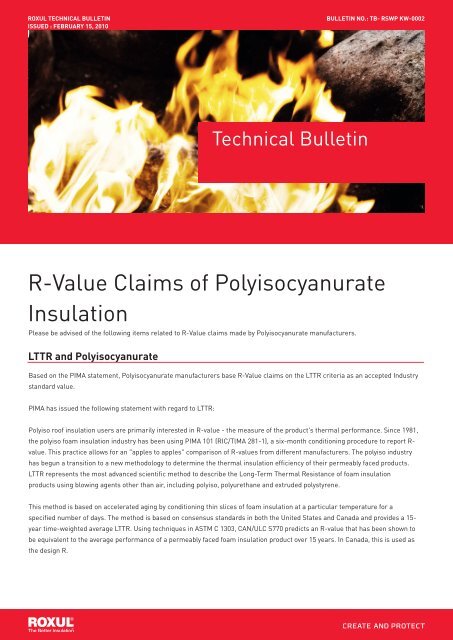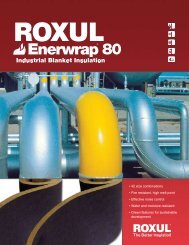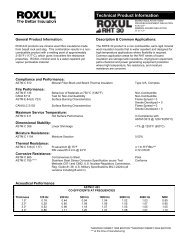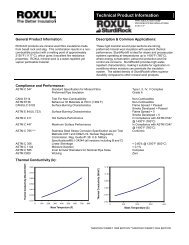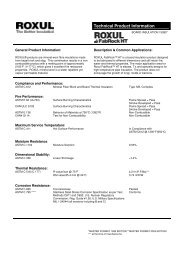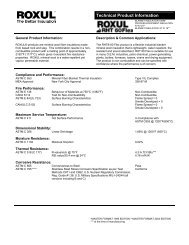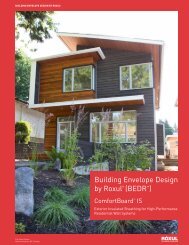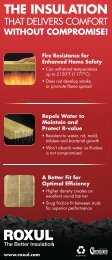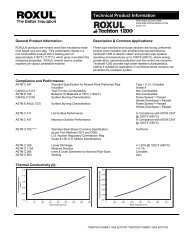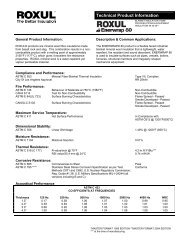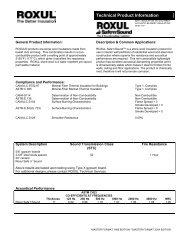R-Value Claims of Polyisocyanurate Insulation - RSPEC
R-Value Claims of Polyisocyanurate Insulation - RSPEC
R-Value Claims of Polyisocyanurate Insulation - RSPEC
Create successful ePaper yourself
Turn your PDF publications into a flip-book with our unique Google optimized e-Paper software.
ROXUL TECHNICAL BULLETIN<br />
ISSUED : FEBRUARY 15, 2010<br />
BULLETIN NO.: TB- RSWP KW-0002<br />
Technical Bulletin<br />
R-<strong>Value</strong> <strong>Claims</strong> <strong>of</strong> <strong>Polyisocyanurate</strong><br />
<strong>Insulation</strong><br />
Please be advised <strong>of</strong> the following items related to R-<strong>Value</strong> claims made by <strong>Polyisocyanurate</strong> manufacturers.<br />
LTTR and <strong>Polyisocyanurate</strong><br />
Based on the PIMA statement, <strong>Polyisocyanurate</strong> manufacturers base R-<strong>Value</strong> claims on the LTTR criteria as an accepted Industry<br />
standard value.<br />
PIMA has issued the following statement with regard to LTTR:<br />
Polyiso ro<strong>of</strong> insulation users are primarily interested in R-value - the measure <strong>of</strong> the product's thermal performance. Since 1981,<br />
the polyiso foam insulation industry has been using PIMA 101 (RIC/TlMA 281-1), a six-month conditioning procedure to report R-<br />
value. This practice allows for an "apples to apples" comparison <strong>of</strong> R-values from different manufacturers. The polyiso industry<br />
has begun a transition to a new methodology to determine the thermal insulation efficiency <strong>of</strong> their permeably faced products.<br />
LTTR represents the most advanced scientific method to describe the Long-Term Thermal Resistance <strong>of</strong> foam insulation<br />
products using blowing agents other than air, including polyiso, polyurethane and extruded polystyrene.<br />
This method is based on accelerated aging by conditioning thin slices <strong>of</strong> foam insulation at a particular temperature for a<br />
specified number <strong>of</strong> days. The method is based on consensus standards in both the United States and Canada and provides a 15-<br />
year time-weighted average LTTR. Using techniques in ASTM C 1303, CAN/ULC S770 predicts an R-value that has been shown to<br />
be equivalent to the average performance <strong>of</strong> a permeably faced foam insulation product over 15 years. In Canada, this is used as<br />
the design R.
NRCA and LTTR<br />
NRCA recommends an R-value <strong>of</strong> 5.6 per inch (25 mm) thickness be used to calculate the total thermal resistance <strong>of</strong><br />
polyisocyanurate foam board ro<strong>of</strong> insulation. This 5.6 R-value is based upon an in-service R-value. Most manufacturers' currently<br />
published literature provides for R-value data for polyisocyanurate foam board ro<strong>of</strong> insulation based upon the long-term thermal<br />
resistance (LTTR) method <strong>of</strong> determination. The LTTR method provides for reporting <strong>of</strong> R-value based upon a calculated 15-year<br />
time-weighted average. At this time, NRCA does not endorse or recommend the use <strong>of</strong> the LTTR method for determining the<br />
thermal resistance <strong>of</strong> <strong>Polyisocyanurate</strong> foam board ro<strong>of</strong> insulation.<br />
R-<strong>Value</strong> vs. Guarantee <strong>Claims</strong><br />
There are many manufacturers <strong>of</strong> polyisocyanurate insulation, each making their own claims in their guarantees. In some cases<br />
the R-value may not be guaranteed for the period <strong>of</strong> time assumed by the designer or owner and may only be guaranteed for a<br />
very short period <strong>of</strong> time. Any energy savings calculations or life cycle analysis should take the manufacturers guarantees into<br />
consideration. Guarantees <strong>of</strong>ten reflect the real world experience <strong>of</strong> the manufacturer.<br />
FOR PROFESSIONAL USE ONLY


